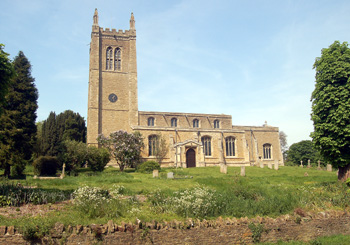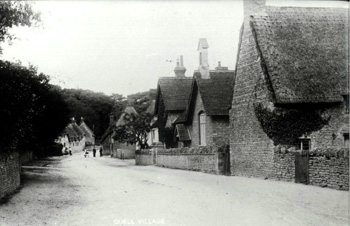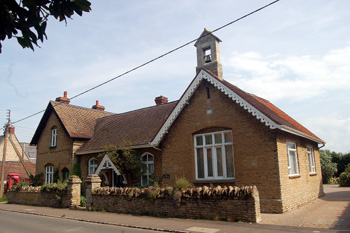Odell School

Odell church from the south May 2008
Volume 81 published by Bedfordshire Historical Records Society (2002) is a series of episcopal visitations undertaken in the first twenty years of the 18th century, edited by former County Archivist Patricia Bell. At each visitation a list of questions was sent out in advance, one of which enquired about the provision of schools in each parish. The various replies for Odell were as follows:
- 1706: "There is no Lecture, School, Almshouse or Hospital endowed in this parish";
- 1709: "No public or charity Schole";
- 1717: "There is no Publick endowed school in the Parish. There is a small private school and all necessary care is taken for the Instruction of the Children";
- 1720: "There is no publick endowed school in the Parish. there is a small private school, and all necessary care is taken for the Instruction of the Children"
In 1818 a Select Committee was established to enquire into educational provision for the poor. This was no doubt prompted, in part, by the recent foundation of two societies promoting education and specifically the building of schools. The Society for Promoting the Lancasterian System for the Education of the Poor was established in 1808 promoting schools run along the lines pioneered by Joseph Lancaster, who had himself copied those of Dr.Andrew Bell, in which older children taught their younger fellows. The Society was renamed the British and Foreign School Society in 1814,. It was supported by a number of prominent nonconformists, Lancaster himself was a Quaker, and sought to teach a non-sectarian curriculum. In answer to this perceived nonconformist takeover of local education the National Society was formed in 1811 to encourage the teaching of poor children along Anglican lines, including the catechism. The Select Committee sent a questionnaire to all parishes in the country asking for: particulars relating to endowments for the education of children; other educational institutions; observations of parish needs etc. Vere John Alston, the curate, wrote that ‘the poorer classes are desirous of the means of education.’ At that time the only education available was through the Sunday school which taught about 40 children. The salary of the teachers was raised through subscriptions. In those days a Sunday School was just that, a school which met on a Sunday, usually in the church or nonconformist chapel or other similar building, teaching more than the religious topics with which they are associated today.
In the country generally the number of schools built continued to grow over the next fifteen years so that by 1833 the government agreed to supplement the work of the two societies, and local benefactors, by making £20,000 per annum available in grants to help build schools. It also prompted another questionnaire to be sent to each parish in England asking for details of local educational provision. Odell had three Sunday Schools, two of them Church of England, with 18 boys and 45 females; the other, which had begun in 1830, of 20 boys, was run by Independents and maintained by subscription.
The next national enquiry was in 1846/7 when the Church of England made an enquiry as to all its church schools. This was against the background of a new Whig government which championed secular education and the increasing importance of nonconformists, particularly Wesleyan Methodist, and Roman Catholics in providing schools. The Rector reported that a day school for 11 boys and 36 girls was "supported by the Clergyman. A schoolhouse and a good master are sadly wanted". The Sunday School contained 26 boys and 36 girls.
In 1854 part of the glebeland was transferred to trustees as the site for a school [P115/29/1] but directories state that the school was not built until 1860. This is supported by the following letter, written on Monday 7th March 1860 by the Rector [BS599]:
"I thought you replied rather unkindly to my last letter; refusing as you did all aid and even sympathy. And yet I quite hoped to have both, when there could be no difference of opinion about the importance of the work, which I began at such a risk, and with so great anxiety. Now I ask you, sir, with all respect to reconsider your decision if perhaps the following statements will induce you to do so. A very substantial School with accommodation for 100, and a good House has been built. This has cost nearly £300, of which there remains not much more than £20 as a debt. I should like assistance towards paying this, as I have already paid £25 towards the object, and my friends have been very liberal subscribers. But what I wish especially to put before you is this, that I have engaged the services of a very experienced master and mistress. They commenced last week, and we have already from 50 to 60 children, ages from 4 to 15".
"Now, sir, in this most ignorant and immoral village, in which you are a proprietor, and receive a yearly income much larger tha I do as curate - has not this good work a claim of support. I have said that I will be responsible for the payment for one year of the salary of the master which is £50 if there are besides of course heavy working expenses".
"Will you bear a part in carrying on this work, which is no theory or scheme, but an actual success. It should be sustained and I feel that if you really knew what good has been done, and at what a personal sacrifice, you would willingly put your name down as an annual subscriber. I would rather not speak of myself, but I would desire that you should make enquiry, either in the village or of the gentry about".
"Last year we had three commitments to gaol of grown boys who were utterly unable to discern between right and wrong and there were constant proofs of the sadness of leaving people untaught".
The first Education Act was passed in 1870 (more correctly it was known as the Elementary Education Act). It was a milestone in the provision of education in Britain demonstrating central government's unequivocal support for education of all classes across the country. It also sought to secularise education by allowing the creation of School Boards. These were groups of representatives, elected by the local ratepayers and the Board had the powers to raise funds to form a local rate to support local education, build and run schools, pay the fees of the poorest children, make local school attendance compulsory between the ages of 5 and 13 and could even support local church schools, though in practice they replaced them, turning them into Board run schools (known as Board Schools). Naturally, and luckily for local historians, the Act required a questionnaire of local schools in 1870. The return for Odell stated that no efficient school existed, saying: "A school for 88 children, near the Church" was required. The return went on "If the Odell Church of England School be at once made efficient by appointing a certified teacher, no further accommodation will be required".
The Odell School logbook shows the effect that the local lace industry had on school attendance around this time. On 13th July 1877 the school was visited by the Factory Inspector concerning the half timers who were at Lace School for part of each day. On the 16th many of the half timers were late into school and told the teacher that: "Mrs Coleman, the Lace Mistress, would not let them come". On the 23rd a letter was received from the Factory Inspector ‘to the effect that the half timers were to attend the full 3 hours, and that he had officially informed and cautioned Mrs Coleman.’ Children also worked for local farmers; especially at harvest time. The entry for September 25th 1882 reads: "Reopened school today. A great many children away. Gleaning not quite over" [SDOdell1/1].

Odell Public Elementary School and High Street about 1920 [Z50/86/13]
A land mark Education Act was passed in 1902, coming into effect in 1903. It disbanded the School Boards and gave day to day running of education to newly formed Local Education Authorities, usually the county council, as in Bedfordshire. The old Board Schools thus became Council Schools whilst the old National, British and other non-Board schools became known as Public Elementary Schools. Odell had never formed a School Board and thus the Church of England School became a Public Elementary School.
Bedfordshire & Luton Archives & Records Service has a scrapbook of cuttings of visits made to most Bedfordshire Schools by School Inspectors for a period from just before the First World War through the inter-war years [E/IN1/1]. The first report in the volume is from 1911, average attendance 38: "Discipline and tone continue to be very good; the School is carefully taught and in most branches of their work the children make satisfactory progress". The next inspection in the volume is not until eleven years later, when average attendance had sunk to 28: "In this little School, although the Head Teacher works conscientiously, the attainments of the children in several subjects do not reach so high a level as might reasonably be expected. In particular Arithmetic, Composition, History and Geography should improve. Physical Exercises, which were seen at the visit in September, are quite promising, and creditable progress has of late been made in Singing".
In 1925, when average attendance was 17, the inspector remarked: "Of eighteen children on the register seven were absent all May and June through whooping cough, and two others have been absent a year or more through other ailments. In Arithmetic the children should be more careful. Reading, Writing and Physical Training are generally satisfactory, and Composition and Drawing are fairly good on the whole, but Geography and History are weak. Indiscriminate answering, which prevails to a considerable extent, should not be permitted". Another visit was made the next year because: "Since the last report the school has been very unfortunate in epidemic sickness, and, for so small a number on the roll admissions from other schools and late admissions of children from a distance account for a large percentage of those in attendance now" - average attendance was just thirteen! The inspector went on: "The Head Teacher was at a loss how to organise the various groups at the earlier visit. She was sent to other schools and has, to a great extent, profited by her experience. The work has materially improved in the intervening months: but even now the arrangement of Time is capable of improvement…it is hoped that more business-like methods will improve the school further".
Two years later, in 1928, average attendance had sunk to a new low of twelve, however: "Since the date of the last report there has been improvement in the work of this School. Practically all of the written work is neat. Arithmetic is accurate as far as it goes, but it is restricted to a few rules and there is not much difference in the work of the Standards as there should be…In oral work some of the children answered well and proved that if they are made to think for themselves they can rise to the occasion. There is a tendency on the part of the Head Mistress to talk too much and to tell the scholars too much instead of making them find out things for themselves…The infants dramatised a few nursery rhymes prettily"
The final inspection in the volume dates to 1933 when average attendance has reached the dizzying heights of twenty: "The School has definitely improved since the last report", the report concluded with the somewhat cryptic observation: "The School, though with a somewhat different atmosphere from others which deserve the compliment, is a happy family party"In 1927 Odell was valued under the terms of the Rating and Valuation Act 1925; Everton piece of land and building in the country was valued to determine the rates to be paid upon it. The valuer visiting the Schoolhouse [DV1/C166/43] noted that it was occupied by Mrs Leach, was of a stone and tile construction and semi-detached to school. It contained a living room, kitchen and washhouse downstairs and two bedrooms above; a garden, earth closet and barn lay outside. The valuer remarked: "Good; only nice house in village; very small garden"
On September 11th 1939 25 evacuated children from London attended Odell School. They were taught together in the Infants room. When an inspector visited the school in March 1940 he was: "alarmed to see the bad structural condition of the room in which these children were being housed". By this time many of the evacuees were returning to London due to the lack of bombing during the early months of the war. VE Day was on May 8th 1945, the logbook notes: "Met at school at 9 a.m. for short service of praise and thanksgiving. Closed school for two days holiday". [SDOdell1/2]
The third of the great Education Acts was that of 1944 which established the principle of County Primary Schools for children up to the age of 11, at which time they took an examination to determine the nature of the secondary school they would attend until they were 15, the most academically able going to grammar schools, the rest to secondary or secondary modern schools. The act also created two types of successor to the public elementary schools - the Voluntary Aided and Voluntary Controlled schools. Voluntary Aided schools are those in which the Local Education Authority funds the school but the governing body is independent, they are usually Anglican or Roman Catholic schools. Voluntary Controlled schools own their own buildings whilst the staff are employed directly by the governors. Odell Public Elementary School became Odell Voluntary Controlled County Primary School.
In the 1970s Bedfordshire County Council introduced comprehensive education, doing away with the 11+ examination and grammar schools and introducing a tier of school between the old County Primary and County Secondary Schools. Thus Lower Schools now taught children aged 4 to 9, Middle Schools from 9 to 13 and Upper Schools from 13 onwards. Odell duly became a Voluntary Controlled Lower School but closed in 1983 due to falling pupil numbers. The school building is now a private house.
 Old School May 2008
Old School May 2008